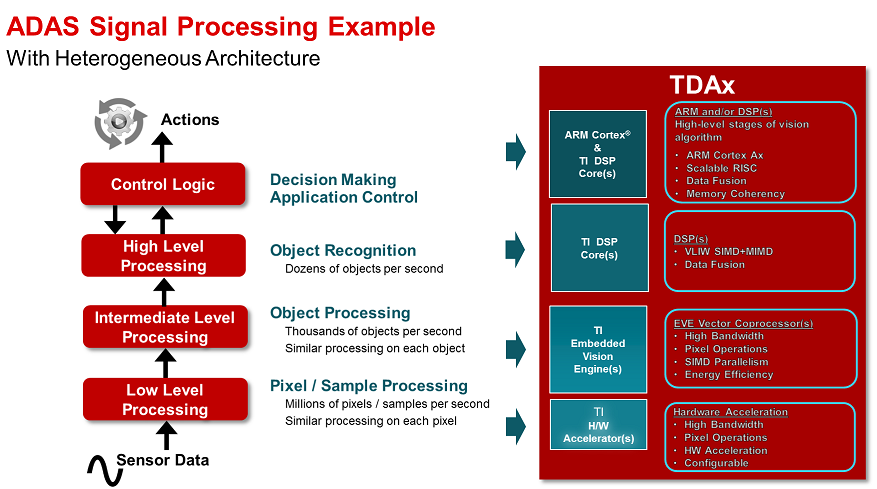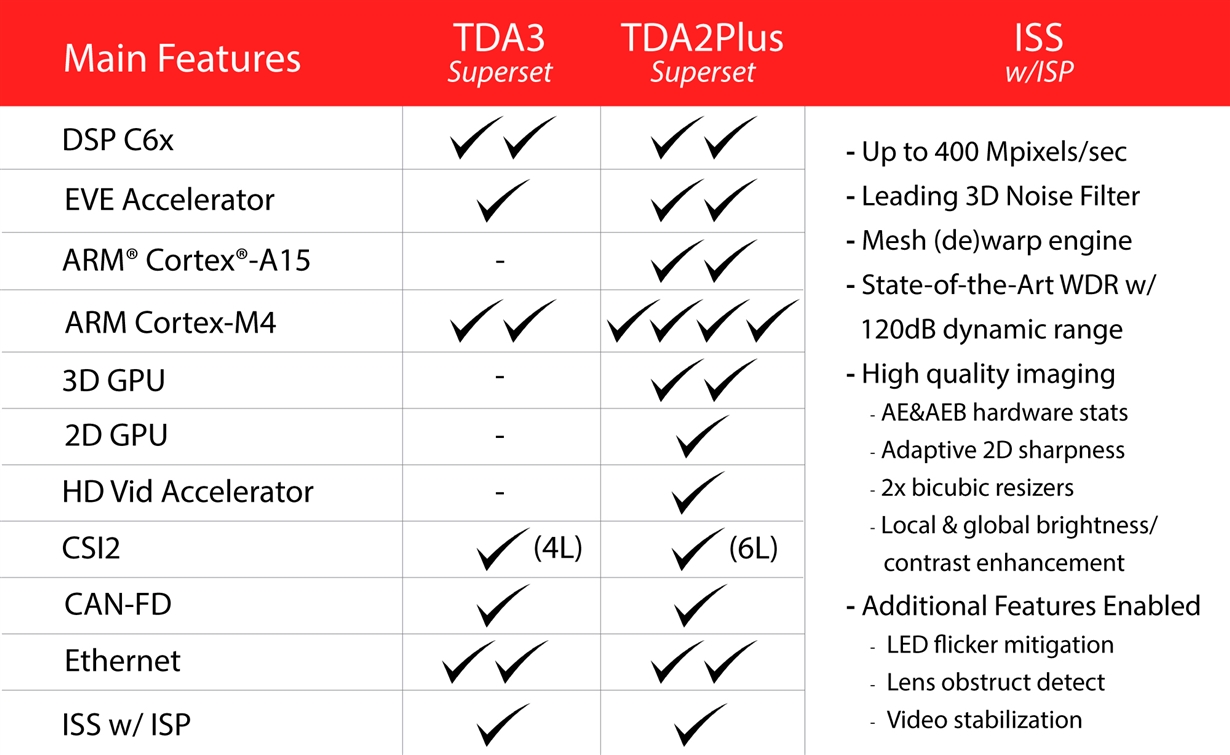Vehicle Vision: Beyond the Crystal Ball?
Joe Folkens
When we look back 20 years from now, automotive evolution will likely be considered the greatest in recent times. Future automotive evolution will be profoundly impacted by automating the task of driving. While there are many aspects to achieving safe and reliable semi-autonomous and fully autonomous driving, it’s clear it will require a “vision” system that is accurate, reliable and can fit into reasonable budgets as well. Multiple modalities, such as camera, ultrasonic, RADAR and LIDAR sensing, when fused together, can greatly increase the reliability of resulting data used to determine a vehicle’s course of action. The processing of all these signal types is critical and ultimately needs to be accomplished within reasonable power, price and performance budgets that can support a safer, reliable and commercially viable solution.
Texas Instruments’ long history in signal processing and the automotive market drives advancement in the development of our automotive processors. To date, TI has shipped over 150 million units into this market. The experience gained by working with major customers to create automotive grade products for more than a decade has facilitated our development of a scalable, cost-effective family of devices offering our customers the best compute per watt solutions targeted for Advanced Driver Assist Systems (ADAS). These systems are the building blocks for near-term, semi-autonomous driving and safety functions as well as long-term, fully autonomous vehicles. Digital signal processing (DSP) is at the core of TI’s Driver Assist (TDAx) family and our extensive experience in this market has driven us to also implement on-chip accelerators of specialized functions found in key applications such as automated emergency braking, adaptive cruise control, lane keep assist, traffic sign recognition, surround viewing, self-parking and many others.
These efficient, DSP cores and optimized accelerators for critical functions are augmented by more general purpose ARM® cores for control code and high-level application software. As seen in Figure 1, the heterogeneous architecture of TI’s TDAx family of automotive processors maps extremely well to typical ADAS signal processing functions. Each of these tailored-fit, programmable cores and accelerators are connected by an extremely efficient internal bus fabric to help ensure the highest levels of overall functional utilization. This hardware architecture, along with TI’s Vision SDK, enables very effective solutions for ADAS applications. To learn more about the TDAx heterogeneous architecture, please refer to our corresponding white paper.
 Figure 1 TDAx Heterogeneous
Architecture
Figure 1 TDAx Heterogeneous
Architecture Given the automotive market’s evolution toward broader and deeper ADAS functions, there is a very real need for scalable solutions to address the different price and performance points required for these various systems. The TDAx family offers this via its heterogeneous architecture (from a core multiplier and frequency perspective) that also enables software compatibility and extensibility. This provides an optimized fit for a specific ADAS system whether it is a forward vision system that includes both camera and radar sensing, a four-camera surround view system with self-parking, a camera mirror replacement system with blind spot detection, or other various types of ADAS systems. Building solutions on this scalable architecture saves time and money as well as promotes faster product development over time.
One of these aforementioned evolutions is the use of smaller-sized, cost-reduced camera modules that do not include an integrated image signal processor (ISP). The elimination of the in-module ISP not only helps reduce the camera size and cost, it also helps to significantly reduce the power consumption and resultant heat, which can be detrimental to the image quality captured by the sensor. Furthermore, these contemporary camera modules typically use a low voltage differential signaling (LVDS) interface instead of Ethernet to further help reduce size, cost and heat. The image data provided upstream is not compressed and is sent “raw” (no loss) for processing in the corresponding SoC, such as TDAx. This helps promote image quality and ultimately provide for a more reliable and potentially safer solution. To take advantage of this trend, both the current TDA3 and upcoming TDA2Plus families include an integrated sixth generation, high-quality ISP within their imaging subsystem (ISS) in addition to the other cores previously discussed.
 Figure 2 TDA3 and TDA2Plus Feature
Overview
Figure 2 TDA3 and TDA2Plus Feature
OverviewThis subsystem enables easier and higher quality exposure matching of the images as well as lens distortion correction. Other additional processing, such as LED flicker mitigation, can also be easily afforded given the architecture and available cores on these devices. Figure 2 provides an overview of TDA3 and TDA2Plus offerings with integrated ISS and some of its many features. To learn more about integrated ISS on TDA devices, please refer to our corresponding white paper. These image processing capabilities along with the TDAx DSP and EVE cores provide a very compelling solution for fusing multiple sensing modalities to create a more reliable and safer system. The TDAx family continues to evolve to address the trends within the automotive ADAS market and provides the best balanced and scalable solutions for enabling these functions across a family of vehicles.
The TDAx devices from Texas Instruments along with other supporting automotive grade components, such as PMICs and FPD-Link serializers/deserializers, can be found on http://www.ti.com.
Want to learn more? See below for related content you may be interested in:
IMPORTANT NOTICE AND DISCLAIMER
TI PROVIDES TECHNICAL AND RELIABILITY DATA (INCLUDING DATASHEETS), DESIGN RESOURCES (INCLUDING REFERENCE DESIGNS), APPLICATION OR OTHER DESIGN ADVICE, WEB TOOLS, SAFETY INFORMATION, AND OTHER RESOURCES “AS IS” AND WITH ALL FAULTS, AND DISCLAIMS ALL WARRANTIES, EXPRESS AND IMPLIED, INCLUDING WITHOUT LIMITATION ANY IMPLIED WARRANTIES OF MERCHANTABILITY, FITNESS FOR A PARTICULAR PURPOSE OR NON-INFRINGEMENT OF THIRD PARTY INTELLECTUAL PROPERTY RIGHTS.
These resources are intended for skilled developers designing with TI products. You are solely responsible for (1) selecting the appropriate TI products for your application, (2) designing, validating and testing your application, and (3) ensuring your application meets applicable standards, and any other safety, security, or other requirements. These resources are subject to change without notice. TI grants you permission to use these resources only for development of an application that uses the TI products described in the resource. Other reproduction and display of these resources is prohibited. No license is granted to any other TI intellectual property right or to any third party intellectual property right. TI disclaims responsibility for, and you will fully indemnify TI and its representatives against, any claims, damages, costs, losses, and liabilities arising out of your use of these resources.
TI’s products are provided subject to TI’s Terms of Sale (www.ti.com/legal/termsofsale.html) or other applicable terms available either on ti.com or provided in conjunction with such TI products. TI’s provision of these resources does not expand or otherwise alter TI’s applicable warranties or warranty disclaimers for TI products.
Mailing Address: Texas Instruments, Post Office Box 655303, Dallas, Texas 75265
Copyright © 2023, Texas Instruments Incorporated